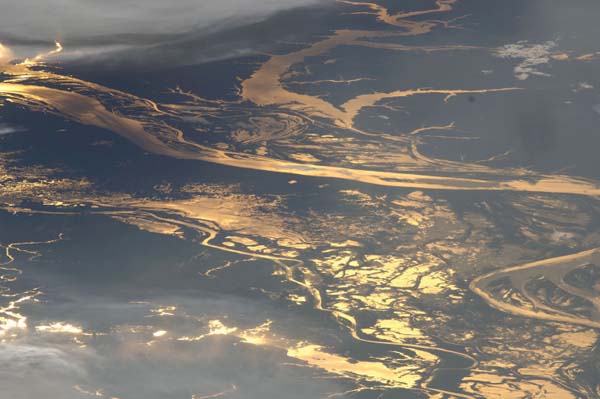Chile, Peru Put the Brakes on Mega-Hydro Projects
Weeks after Brazil’s environmental agency, IBAMA, granted final approval for construction of the mammoth 11.2-GW Belo Monte Dam in the Amazon region to proceed, an appeals court in Chile suspended plans for the 2.75-GW multi-dam HidroAysen project in the Patagonia region, and Peru’s government terminated a concession for the 1.5-GW Inambari in the Peruvian Amazon area after month-long mass protests (Figure 5).
 |
| 5. Cutting the water off to hydropower. Environmental activism in Chile and Peru has thwarted plans to build two major hydro projects: the 2.75-GW multi-dam HidroAysen project in the Patagonia region, and the 1.5-GW Inambari in the Peruvian Amazon area. Meanwhile, Brazil, whose economic growth depends on robust energy expansion, continues to support the mammoth 11.2-GW Belo Monte Dam proposed for the Xingu River in the Amazon region and depends on power imported from the Peruvian Amazon. This NASA image shows the setting sun glinting off 150 kilometers (93 miles) of the sinuous Amazon River and numerous lakes in its floodplain, some 1,000 kilometers inland from the Atlantic Ocean. Source: NASA |
The Brazilian government granted a license to the controversial Belo Monte Dam on the Xingu River, which has also faced fierce opposition from environmental groups concerning impacts on the ecosystem and wildlife in the region, after a “robust technical analysis.” The Norte Energia consortium can now begin work on the project, scheduled for completion by 2019.
But in Chile, where several citizen and environmental groups legally challenged the US$3.2 billion HidroAysen hydroelectric project, an appellate court judge in Puerto Montt ruled that the government neglected to consider several issues, including that the environmental impact study did not contain enough baseline information. The Aysén Environmental Review Commission had approved the project in May after a three-year environmental review.
The court issued injunctions against the project, which means work by its developers—Chile’s Endesa and the Spanish firm Colbun—has been halted until the project is reevaluated, which could take three months or more. The project calls for construction of five plants on two rivers—two plants on the Baker River and three on the Pascua River—all of which would require reservoirs to be built.
In Peru, meanwhile, after 2,000 people in the Puno area of the Peruvian Amazon went on strike to force the government to cancel mining concessions and to review construction of the Inambari Dam, Commission Chair and Vice-Minister of Energy Luis Gonzales Talledo cancelled the project, stating that the Brazilian consortium Empresa de Generación Eléctrica Amazonas Sur’s (Egasur’s) rights to develop the project had been revoked.
The dam was to be built 300 kilometers (km) from the Brazilian border and would have flooded 410 square km of forest—including some 60 villages. It would have been the first of at least six hydropower projects that are part of an energy agreement signed by Peru and Brazil in June 2010. About 80% of the power generated by the US$4 billion hydro plant would have been exported to Brazil, though Peru would own the plant after 30 years, according to the agreement. Egasur has said that people displaced by the dam would be rehoused in better conditions.
The second proposed dam under the agreement—the 2-GW Pakitzapango Dam on the Ene River—is being legally challenged by an environmental group. The five dams under the agreement—Inambari, Pakitzapango, Tambo 40, Tambo 60, and Mainique—are expected to cost around US$16 billion. Financing is anticipated to come from the Brazilian National Development Bank. Brazil’s newest energy expansion plan for 2011–2020 assumes the availability of 7,000 MW of hydropower imported from the Peruvian Amazon region.
Several more mega-dams are in the developmental pipeline in Latin America and the Caribbean, where, according to energy group Olade, 57% of power is sourced from hydro. About 40% is generated by thermo-electric power plants, 2% from nuclear stations, and 1% from wind, solar, and geothermal. The group says Argentina, Mexico, and Costa Rica have projects on the drawing board, and Uruguay, Colombia, and Venezuela—countries that rely heavily on hydropower—are also expected to increase hydroelectric capacity.